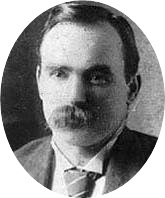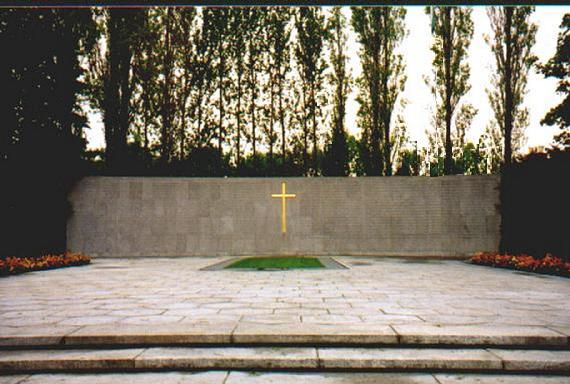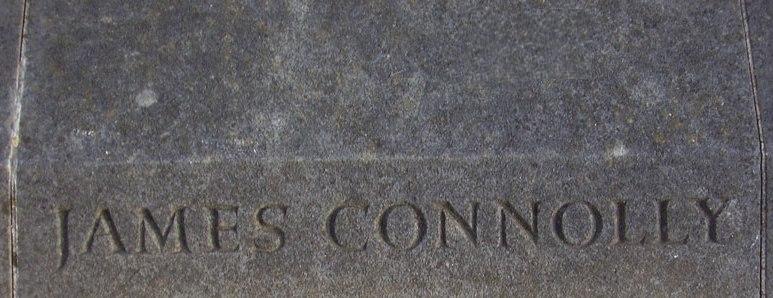|
James
Connolly
(1868
-
1916)
Irish Republican, Labor Leader,
Founder of the Irish Citizen Army, and
Commandant of the Dublin Brigade during the Easter Rising.
 James
Connolly
was
born
in Edinburgh,
Scotland in
June
of
1868,
the
youngest
of
three
sons
born
to
Irish
born
parents,
who
had
emigrated
to
Scotland
in
the
1850’s.
They
lived
in
the Cowgate;
one
of
Edinburgh’s
worst
slums
nicknamed
‘Little
Ireland’
because
so
many
Irish
refugees
from
the
contrived
famine
of
the
1840's
lived
there. Connolly
went
to
St
Patrick's
School in
the Cowgate
until
age
eleven
when
he
left
to
work
at
the Edinburgh
Evening
News,
followed
by
stints
in
a
bakery
and
a
mosaic
tiling
factory.
Although
self-educated
he
went
on
to
become
a
formidable
organizer,
lecturer
and
writer
and
was fluent
in
a
number
of
languages
including
German,
Spanish
and
Italian. James
Connolly
was
born
in Edinburgh,
Scotland in
June
of
1868,
the
youngest
of
three
sons
born
to
Irish
born
parents,
who
had
emigrated
to
Scotland
in
the
1850’s.
They
lived
in
the Cowgate;
one
of
Edinburgh’s
worst
slums
nicknamed
‘Little
Ireland’
because
so
many
Irish
refugees
from
the
contrived
famine
of
the
1840's
lived
there. Connolly
went
to
St
Patrick's
School in
the Cowgate
until
age
eleven
when
he
left
to
work
at
the Edinburgh
Evening
News,
followed
by
stints
in
a
bakery
and
a
mosaic
tiling
factory.
Although
self-educated
he
went
on
to
become
a
formidable
organizer,
lecturer
and
writer
and
was fluent
in
a
number
of
languages
including
German,
Spanish
and
Italian.
In
1882
at
the
age
of
14,
he
joined
the
Second
Battalion
of
the
Royal
Scots. At
that
time
the
army
was
the
only
way
out
of
the
ghetto
for
so
many young
men.
The
alternative
was
a
life
of
poverty
and
despair
compounded
by
rampant
discrimination.
and anti–Irish
prejudice.
He
spent
seven
years
in
the
army
serving
most
of
that
time
in
Ireland,
first
in
Cork and
later
in
Dublin.
While
serving
there
he
witnessed,
first
hand,
the
mistreatment
of
the
Irish
people
by
the
British
army
and
the
ruthless
landlords
they
were
there
to
protect.
In
1889,
having
seen
enough
he
deserted
the
army
and
returned
to
Scotland.
What
he
experienced
during
his
service
in
Ireland
was
to
have
a
major
influence
on
the
rest
of
his
life.
He
also met
his
future
wife,
Lillie
Reynolds,
while
serving
in
Ireland.
After
his
marriage
to
Lillie
in
1890 he
joined
his
father
and
brother
working
as
a
laborer
with
the
Edinburgh
Corporation.
During
this
period
he
became
active
in
socialist
and
trade
union
circles
and
became
secretary
of
the
Scottish
Socialist
Federation
after
his
brother
John,
who
was
secretary,
was
fired
by
the
corporation
for
advocating
an
eight
hour
day.
In
May
of
1896,
at
the
invitation
of
John
Leslie
of
the
Scottish
Socialist,
Connolly
went
to
Dublin
as
a
paid
organizer
for
the
Dublin
Socialist
Society.
As
a
result
of
his
persistent
cajoling
the
society
evolved
into
the
Irish
Socialist
Republican
Party
(ISRP),
who
would
go
on
play
an
important
role
in
the
uprising
1916.
He
was
also
instrumental
in
founded
the
organization’s
newspaper The
Workers
Republic.
In
1902
through 1903
he
completed
lecture
tours
of
Scotland
and
the
United
States
By
late
1903, Connolly
was
the
father
of
six
children.
Conditions
for
the
working
people
in
Ireland
was
hopeless
and
in
an
effort
to
provide
a
better
life
for
his
young
family
he
set
sail
for
the
United
States.
After
his
arrival
and
lived
in Troy,
New
York with
his
cousin
where
he
found
work
with
the Metropolitan
Life
Insurance
Company.
It
took
him
some
time
to
save
enough
to
rent
a
house
and
send
for
his
family.
In
the
summer
of
1904
they
were
all
ready
to
set
sail
and
join
him.
The
night
before
they
were
scheduled
to
depart
his
oldest
child
was
tragically
killed
in
an
accident.
The
James
Connolly
Society
of
Canada
and
the
United
States
erected
a
monument
to
James
Connolly
in
Troy
in
August
of
1986.
In
1905,
Connolly
relocated
with
his
family
to
Newark,
New
Jersey
where
he
worked
as
a
as
a
machinist
with
the
Singer
Sewing
Machine
Company.
In
1906
he
became
a
member
of
the
American
Socialist
Labor
Party and
a
paid
organizer
for
the
Industrial
Workers
of
the
World
(the
“Wobblies”)
founded
in
Chicago
in
1905
by,
amongst
others,
William D. Haywood and Daniel De Leon.
He
also
founded
a
monthly
paper,
the
Harp,
which
aimed
to
reach
Irish
emigrants
and
published
two
pamphlets
on
his
socialist
philosophy
-- The
Axe
to
the
Root
and
Socialism
Made
Easy.
During
his
years
in
the
United
States,
Connolly
retained
a
deep
interest
in
political,
trade
union
and
cultural
events
as
they
unfolded
in
Ireland.
In
1910
his
dream
of
returning
to
Ireland
became
reality
when
former
comrades
invited
him
to
return
to
become
national
organizer
for
the
newly-formed
Socialist
Party
of
Ireland. In
1911
he
was
appointed
Belfast
organizer
for
the
Irish
Transport
and
General
Workers
Union founded
by
Jim
Larkin.
He
became
the
unions
General
Secretary
in
October
of
1914
after
Larkin
departed
for
the
United
States.
In
1912,
he
helped
found
the
Irish Labour
Party
and
was
instrumental
in
reviving
The
Worker’s
Republic
newspaper.
He
also
became
active
in
the
workers
opposition
to
the
Employers
Federation
and
was
instrumental
in
organizing
the
Irish
Citizens
Army
during
the
so-called
Great
Lock-Out
of
1913
to
protect
striking
workers
from
attack
by
goons
hired
by
the
employers.
After
Britain
declared
war
on
Germany
in
August
1914,
Connolly
viewed,
as
did
others
Irish
leaders,
Britain's
involvement
in
yet
another
war
as
an
opportunity
to
strike
a
blow
for
Irish
freedom.
By
January
of
1916
Connolly
had
reached
agreement
with
the Irish
Republican
Brotherhood
Military
Council to
co-operate
in
an
uprising
the
following
Easter.
He
joined
the
Council,
and
on
the
day
before
the
Rising
he
was
appointed
vice-president
of
the
Irish
Republic
and
Commandant-General,
Dublin
Division,
Irish
Army
Connolly
was
one
of
the
seven
signatories
of
the
1916
Proclamation.
On
Easter
Monday,
24th
April,
he
led
the
Headquarters
Battalion
from
Liberty
Hall
to
the
General
Post
Office
where
he
commanded
military
operations,
including
the
construction
of
defenses,
the
placement
of
his
forces
and
the
deployment
of
reinforcements.
He
was
a
fearless
leader
and
the
fact
that
only
nine
volunteers
died
during
the
fighting
is
proof
of
his
extraordinary
leadership
and
tactical
ingenuity.
The
safety
of
his
men
was
paramount
and
even
after
being
severely
wounded
on
27th
April,
he
remained,
as
Patrick
Pearse
said,
"still
the
guiding
brain
of
our
resistance".
After
the
Irish
forces
surrendered
on
April
29th,
Connolly,
was
arrested
with
the
other
leaders,
court-martialed
and
sentenced
to
die
by
firing
squad.
Connolly
offered
no
defense
during
his
sham
court
martial
other
than
the
following
statement;
I don’t wish to make any defense except against charges of wanton cruelty to prisoners. These trifling allegations that have been made in that direction if they record facts that really happened deal only with the almost inevitable incidents of a hurried uprising and overthrowing of long established authorities, and no where show evidence of a set purpose to wantonly injure unarmed prisoners.
We went out to break the connection between this country and the
British Empire and to establish an Irish Republic. We believe that the call we thus issued to the people of Ireland was a holier calling and a holier cause than any call issued to them during this war having any connection with the war. We succeeded in proving that Irishmen are ready to die endeavoring to win for Ireland their national rights which the
British Government has been asking then to die to win for Belgium. As long as that remains the case the cause of Irish Freedom is safe. Believing that the British Government has no right in Ireland, never had any right in Ireland, and never can have any right in Ireland. The presence in any one generation of even a respectable minority of Irishmen ready to die to affirm that truth makes that Government for ever an usurpation, and a crime against human progress. I personally thank God that I have lived to see the day when thousands of Irishmen and boys, and hundreds of Irish women & girls, were equally ready to affirm that truth and seal it with their lives if necessary.
In
the
early
morning
hours
of
12
May
1916,
James
Connolly
was
taken
by
ambulance
from
Dublin
Castle
to
Kilmainham
Jail,
carried
on
a
stretcher
into
the
prison
yard,
strapped
into
a
chair
and
executed.
This
act,
as
well
as
the
execution
of
the
other
leaders,
was
the
catalyst
in
turning
the
Irish
people
against
British
rule.
----------------------------------------------------
Contributed by;
Tomás Ó Coısdealbha
cemetery
AND
grave
location
Name:
Arbour
Hill
Cemetery
PHONE
NO.
+353
1
605
7700
ADDRESS:
Arbour
Hill,
Dublin
West,
Dublin,
Co.
Dublin
Leaders
of
the
1916
uprising
burial
plot



|